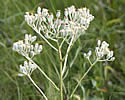Arnoglossum plantagineum (Tuberous Indian Plantain)
| Also known as: | Prairie Indian Plantain, Groovestem Indian Plantain |
|---|---|
| Genus: | Arnoglossum |
| Family: | Asteraceae (Aster) |
| Life cycle: | perennial |
| Origin: | native |
| Status: |
|
| Habitat: | sun; moist to wet; wet and mesic prairie, fens, sedge meadows |
| Bloom season: | June - August |
| Plant height: | 2 to 5 feet |
| Wetland Indicator Status: | GP: FAC MW: FAC NCNE: FAC |
| MN county distribution (click map to enlarge): |  |
| National distribution (click map to enlarge): |  |
Pick an image for a larger view. See the glossary for icon descriptions.
Detailed Information
Flower: 


![[photo of flowers]](/udata/r9ndp23q/white/arnoglossum-plantagineum-tuberous-indian-plantain_0718_162000-t.jpg) Up to 100 stalked flower heads in flat-topped branching clusters, 3 to 10 inches across, at the top of the stem and uppermost leaf axils. Flower heads are about 1/6 inch across, made up of 5 greenish to creamy white disk flowers, each with 5 tightly curled petals. Brown columns of yellow-tipped stamens and brown styles with split tips project well above the petals.
Up to 100 stalked flower heads in flat-topped branching clusters, 3 to 10 inches across, at the top of the stem and uppermost leaf axils. Flower heads are about 1/6 inch across, made up of 5 greenish to creamy white disk flowers, each with 5 tightly curled petals. Brown columns of yellow-tipped stamens and brown styles with split tips project well above the petals.
![[photo of bracts and cluster]](/udata/r9ndp23q/white/arnoglossum-plantagineum-tuberous-indian-plantain_0718_161953-t.jpg) Below the flowers is a cylindrical tube, 1/3 to 3/8 inch long, of 5 light green, oblong bracts with conspicuous white wings along their length. The cluster stalks are light green, smooth and round with a small scale-like bract at their base.
Below the flowers is a cylindrical tube, 1/3 to 3/8 inch long, of 5 light green, oblong bracts with conspicuous white wings along their length. The cluster stalks are light green, smooth and round with a small scale-like bract at their base.
Leaves and stems: 


![[photo of basal leaves]](/udata/r9ndp23q/pd/arnoglossum-plantagineum-7920-4-t.jpg) Leaves are mostly basal, thick and firm, the surfaces smooth with prominent longitudinal nerves, the lowest leaves 2½ to 7½ inches long, ¾ to 3½ inches wide, the edges often wavy and smooth or with shallow teeth, and on a long stalk. Basal leaf shape can be variable but typically egg-shaped, elliptical or spoon-like, sometimes narrowly lance-elliptic. The basal clump may be dense with dozens of leaves or just a few leaves around the stem.
Leaves are mostly basal, thick and firm, the surfaces smooth with prominent longitudinal nerves, the lowest leaves 2½ to 7½ inches long, ¾ to 3½ inches wide, the edges often wavy and smooth or with shallow teeth, and on a long stalk. Basal leaf shape can be variable but typically egg-shaped, elliptical or spoon-like, sometimes narrowly lance-elliptic. The basal clump may be dense with dozens of leaves or just a few leaves around the stem.
![[photo of stem leaves]](/udata/r9ndp23q/pd/arnoglossum-plantagineum-892380-7-t.jpg) Leaves become smaller as they ascend the stem, the blade more broadly egg-shaped with more pronounced, coarse teeth and a shorter stalk. The stem is erect, unbranched, stout, hairless with reddish longitudinal lines.
Leaves become smaller as they ascend the stem, the blade more broadly egg-shaped with more pronounced, coarse teeth and a shorter stalk. The stem is erect, unbranched, stout, hairless with reddish longitudinal lines.
Fruit: 
Fruit is a small, dark brown, bullet shaped seed (achene) with a tuft of spreading white hairs at the tip.
Notes:
Tuberous Indian Plantain was once common in the rich, moist prairies of southeastern Minnesota, but the conversion of most of its habitat to agricultural fields threatens its existence. According to the DNR, the continued conversion of what habitat still remains, along with other practices like heavy grazing, mowing and herbicide use, continue the attrition of its already dwindled numbers. It was listed as a Minnesota Threatened species in 1984 and is currently listed as a Special Concern species in Wisconsin. Tuberous Indian Plantain is easily identified by the winged phyllaries on the flower heads. The leaves are frequently found full of holes, probably from beetles.
Native Plant Nurseries, Restoration and Landscaping Services ↓
More photos
 Tuberous Indian Plantain plant
Tuberous Indian Plantain plant budding plant
budding plant sparse basal leaves
sparse basal leaves dense basal leaves
dense basal leaves variable basal leaf shape
variable basal leaf shape leaves are commonly insect fodder
leaves are commonly insect fodder pre-flowering basal clump
pre-flowering basal clump
Photos by K. Chayka taken at Iron Horse Prairie SNA, Dodge County. Photos courtesy Peter M. Dziuk taken at the Minnesota National Wildlife Refuge, Black Dog Unit, Dakota County, and at Iron Horse Prairie SNA.
Comments
Have you seen this plant in Minnesota, or have any other comments about it?
on: 2017-07-09 19:09:42
Today is July 9...found this for the very first time ever...I really like the crazy vertically stripped stem...leaves are quite unusual...main veins in leaves run vertically also.
on: 2019-02-27 07:53:30
The endangered species lab at the Minnesota Landscape Arboretum in Chaska, MN is conserving this plant. I potted up almost 100 seedlings earlier this week. About that many more to be potted up from the same propagation nursery flats. Good propagation rates. The seedlings will be planted out into the arboretum prairie when big enough to hold there own.






